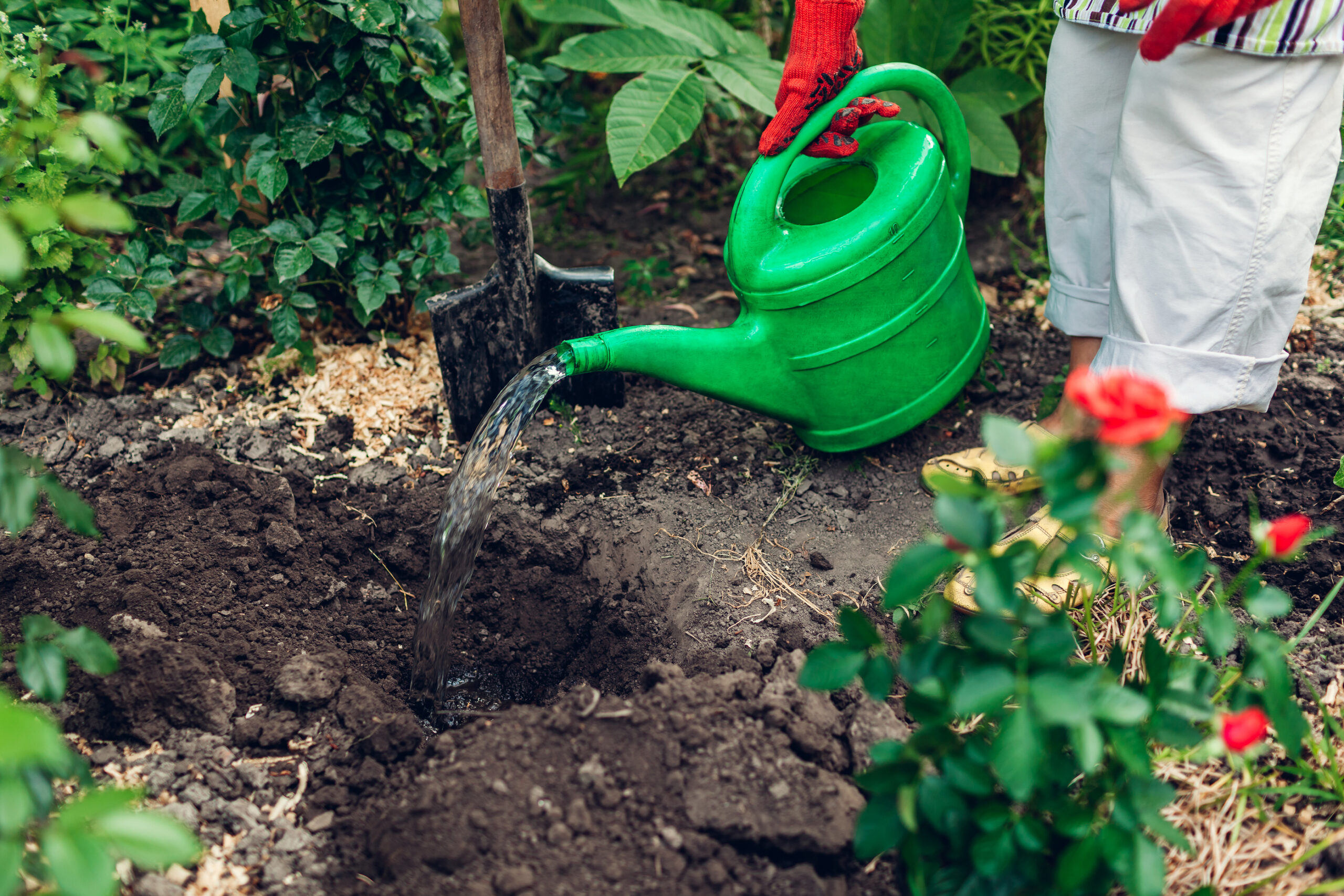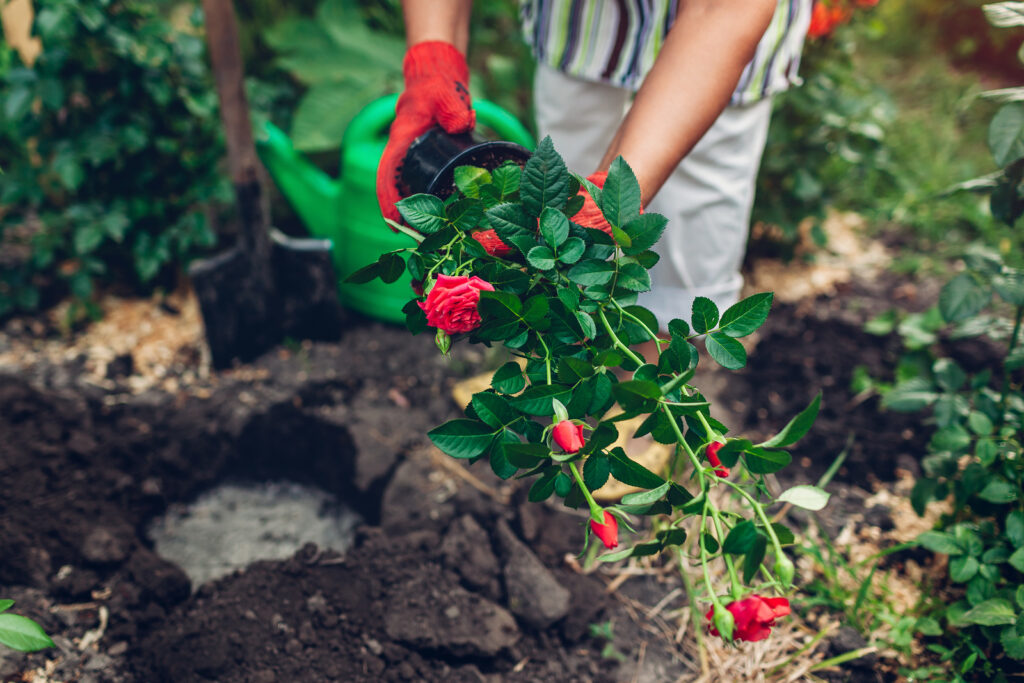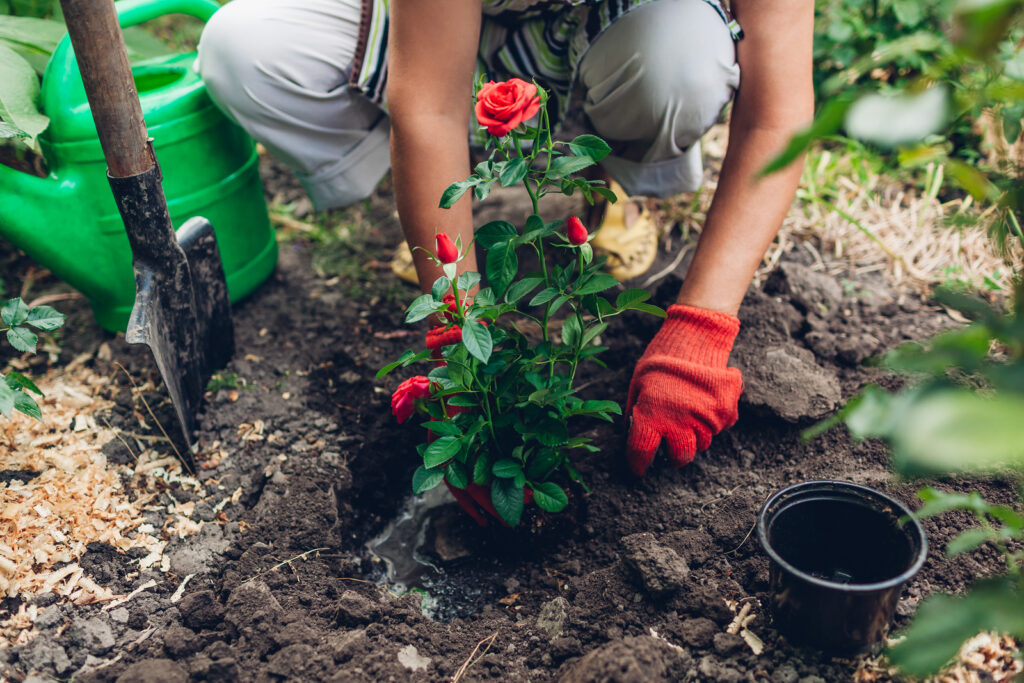Roses are not difficult to grow.
To grow roses in your garden all you need to do is meet their basic needs: choose a suitable site, prepare the soil, and select the right roses for the location.
Roses are long-lived—most roses will be in the garden for 20 years or more. In exchange for the years of beauty and delight roses give, you will spend a minimal amount of time and effort.
Let’s look at how to plant roses step-by-step.

Site and soil for roses
To plant a rose, first identify the right location and soil. Here are a few tips:
- Choose a site that is open, gets 8 hours of sun each day, is sheltered from the prevailing wind, and has good air circulation.
- Choose a site near a water source.
- Clear the planting area of sod and weeds; be sure to eliminate all perennial weeds. Sod and perennial weeds can compete with roses for soil moisture and nutrients.
- Test the soil pH; the optimal soil pH for roses is 6.5—that is slightly acidic soil. Amend the soil as necessary to raise or lower the pH. (You can get amendments and direction at a nearby garden center.)
- Prepare the soil. Turn the soil to 24 inches deep and remove all stones or debris. Add plenty of aged compost or commercial organic planting mix to the bed. Adding organic matter will make the soil both moisture retentive and well-drained.
- If the soil in your garden is difficult to work or if it is not well-drained, build a raised bed. This will lift your plants above a difficult site.
Choosing a rose
When the planting bed is ready, you can select roses to plant. Here are things to consider:
- Size of rose at maturity: consider the planting space; make sure the rose you select will fit the space—not be overcrowded—when it is mature. Do you need a shrub rose, a landscape rose, climbing or rambling rose?
- Bloom color: is flower color important for the garden design?
- Healthy rose: choose a rose—whether bare-root or container-grown—that has at least two or three evenly spaced; the canes should be firm, the greater the diameter of each cane the better. Canes should be intact, healthy, and disease-free; they should be at least 12 inches (30cm) long.
- Bare-root rose: a bare-root rose should be dormant or semi-dormant at planting time; it should not be leafed out or have buds. The roots should be covered with moist peat or sawdust; avoid bare-roots with dry or broken roots.
- Container rose: a container-grown rose should be firmly rooted; hold the rose by the main stem and lift; if the rose pulls away from the soil, it is likely a bare-root rose that has recently been potted; a container-grown rose will be well rooted in the soil. (Bare-root roses are less expensive than established container roses; don’t pay a premium price for a bare-root rose being sold as container-grown.) Make sure roots are not growing through the bottom of the container; this would indicate the plant is root-bound; a pot-bound plant has been in the container too long.

When to plant bare-root roses
- Bare-root roses are best planted in early spring before they begin to leaf out; this is the time bare-roots are commonly available for sale. Purchase and plant bare-root roses in early spring as soon as the soil is workable.
- Bare-root roses should be planted soon after purchase; if you can not plant a bare-root right away, heel it into the soil; that means the roots should be covered with moist soil until planting time.
- If a bare-root can not be heeled in while awaiting planting, keep the roots covered with moist peat or sawdust and place the rose in a cool place that gets no direct sunlight.
When to plant container roses
- Container-grown roses can be planted at any time. Avoid planting a rose during hot, dry weather or during freezing weather.
- While awaiting planting, keep container-grown roses watered; do not let the soil dry out.
- A rose in a container should be protected from freezing winter weather; place the rose in a cool, but not freezing place until temperatures moderate and the soil can be worked in spring.

Preparing a bare-root rose for planting
- Remove the bare-root rose from its box or package.
- Remove any soil, peat, or sawdust around the bare roots
- Gently separate or tease out the roots; trim away broken or damaged roots.
- Set the roots in a bucket of water for an hour or two so that they plump up with moisture; this is especially important if the roots look dry.
Planting a bush rose
- Prepare a planting hole that is wide enough to accommodate the roots or the root ball; the hole should be deep enough that the bud union (where the cane stem is grafted to the rootstock) is at the right level for your region (in USDA Zones 5-6, the union should be planted 1 inch (2.5cm) below ground; in Zones 7-8, the union should be level with the ground; in Zones 9-10, the union should be 1 inch above the ground level). Start with a hole twice as deep and wide as the root ball; backfill as needed.
- Position the rose at the center of the hole and check the planting depth; backfill soil as necessary to achieve the proper depth.
- If the rose is bare-root, fan the roots out in all directions. You can mound soil at the bottom of the hole to form a cone then set the plant on top of the cone and fan out the roots.
- If the rose is container-grown, make sure the roots are not circling; tease them loose as necessary. The ends of healthy roots will be white; trim away roots that are brown or dry.
- Backfill the hole in stages, adjusting the height and position of the rose as necessary; water in the soil as you backfill. Firm the soil around the roots to get rid of air pockets but do not compact wet soil.
- Backfill the hole to ground level for a container rose. For a bare-root rose, backfill and mound the soil up for the union and up the cane a few inches. Wash this soil away over the next two weeks when you water. Use soil to create a basin for watering around the plant.
- Mulch around the plant with aged compost, straw, or chopped leaves to slow soil moisture evaporation and keep down weeds.
- Remove large flowers and buds from newly planted container-grown roses.
- If the weather is hot and dry, spray the plant with an antidesiccant.

Planting a climbing rose
- Train climbers against a wall, trellis, or fence.
- Train canes of the climber up to horizontal wires or trellis cross pieces set about 18 inches (45cm) apart; wires can be held in place by tapered vine eyes or strong nails. Wires or trellis should be at least 3 inches (7cm) away from the wall; this will allow for air circulation.
- Set the rose about 18 inches (45cm) away from the wall or trellis.
- Position the rose leaning toward the wall or trellis at a 45° angle.
- Fan out the roots into moist soil.
- Attach the canes to the horizontal wires or trellis with elastic horticultural tape; do not tighten the ties too tight.
Planting a standard rose
- Prepare the planting hole as described above.
- A standard rose (tree rose) needs the support of a stake placed on the side of the prevailing wind. Use a natural stake without preservatives. Place the stake in the hole and drive into the soil before setting the rose in the hole.
- Position the rose next to the stake; the stake should reach as high as the lowest branches.
- Backfill the soil and water.
- Secure the stem of the rose to the stake with elastic garden ties; do not tighten the ties too tight.

Planting a rose in a container
- The container should be at least 12 to 18 inches deep for a bush rose, 9 to 14 inches deep for a miniature rose.
- Place a piece of screening over the drainage holes.
- Fill the container with a soil-based potting mix.
- Plant the roses in the same way and at the correct depth as you would bush roses (see above).
Rose care after planting
- Keep newly planted roses well-watered; the soil should be evenly moist, not wet, not dry.
- When the plant begins to send up new growth, feed the rose with an all-purpose fertilizer; organic fertilizers are slow-release and will feed the plant for several months.
- Mulch around newly planted roses with 3 inches of aged compost or organic commercial planting mix; this will help keep down weeds, slow soil moisture evaporation, and feed the soil.
- Where freezing weather comes in winter, protect the rose with a plant blanket or heap straw up around the plant.
Also of interest:















